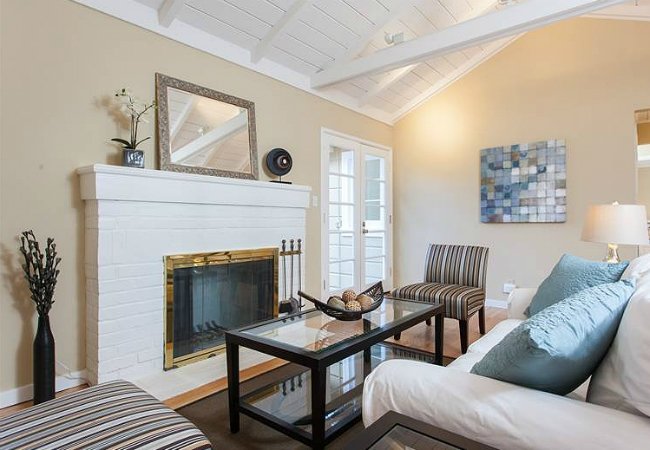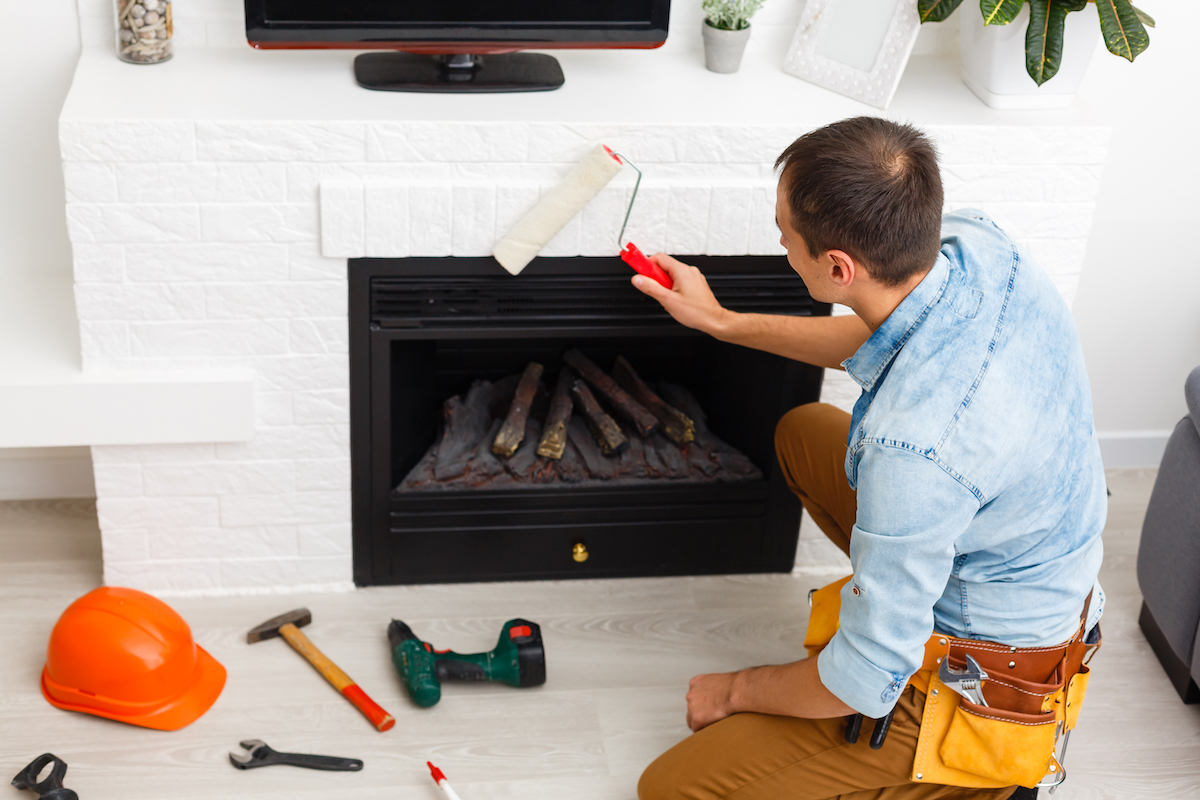We may earn revenue from the products available on this page and participate in affiliate programs. Learn More ›
Sometimes, even despite attentive maintenance and care, brick masonry fireplaces amass a fair amount soot, mildew, and efflorescence that cumulatively dates a modern home. While a teardown of this brick feature for something more modern can be cost-prohibitive to many homeowners, you can still brush off outdated design before winter’s cold arrival by brushing up your fireplace exterior—with paint. Unlike drywall or wood, brick has a unique texture that should be taken into consideration when painting. Follow this tutorial to fix up your bare brick masonry fireplace in under a weekend.
Tools & Materials
Bobvila.com may earn a commission from purchases made through these links.
- Stiff-bristle brush
- Wire brush
- Acrylic caulk
- Painter’s tape
- Drop cloth
- Paint roller frame
- 1 ¼” thick-nap roller cover
- Telescopic roller extension pole
- 2-inch paintbrush
- 5-gallon buckets
- Paint bucket screens
- Mild liquid dish soap
- Trisodium phosphate
- Bleach
- Masonry primer
- Acrylic latex paint
Step 1: Scrub the brick clean.
Due to the tendency of brick to accumulate grit, you should wet and clean the brick fireplace prior to painting it to ensure better paint adhesion. Using a stiff-bristle brush doused in soapy water, first scrub the face of the brick fireplace with a brush to remove dirt or efflorescence—that is, white, powdery, mineral deposits. If your fireplace also contains leftover soot, follow with a mixture of 1/2 cup of trisodium phosphate and 1 gallon of water.
Next, remove any visible mildew with a solution of one part bleach to three parts water. Sponge the diluted bleach over your brick, let it soak in for for half an hour, and scrub the surface with a wire brush. Once you’ve wrapped up cleaning, allow the brick to dry for at least 24 hours before painting it.

Tried-and-True Advice
“Brick and masonry surfaces require a different type of paint brush and roller than what works on flat surface. Look for a paint roller with a 1 1/4-inch nap and a stiff paint brush. A flatter roller and a soft brush won’t deliver the paint as well on the textured surface.”
—Theresa Clement, Contributing Editor and Writer
Step 2: Inspect the fireplace.

Inspect the fireplace for small cracks in the brick. If you find any, fill them in with acrylic caulk. Check the package’s instructions for required dry time before moving on to the next step.
Step 3: Prepare for painting.
Using painter’s tape, cover the areas around the fireplace that you do not want to paint, such as where the brick meets the floor and walls. Protect the floor and the fireplace hearth from splatter by laying out a drop cloth.
Step 4: Prime the brick.
Pour your masonry primer into one of the 5-gallon buckets and insert a bucket screen on end; this painting tool will assist in both minimizing mess and achieving an even coat on your roller. Dip the roller into the bucket, roll it along the screen, and repeat until it’s completely loaded with primer.
Carefully apply the first coat of primer to the brick, ensuring that you cover the surface as well as the mortar joints. To paint deep joints that the roller misses, switch to a paint brush. If your brick structure reaches the ceiling, use a telescopic roller extension pole to access hard-to-reach areas near the top of the fireplace.
Apply an additional coat of two of primer to areas where you cleaned efflorescence in Step 1. Then, wash up your painting tools and allow the primer to dry overnight.
Step 5: Paint the brick.
The next day, set out to prep your acrylic latex paint the same way you had your primer in the second 5-gallon bucket with its own bucket screen. (While you can choose any paint finish, a matte paint really complements the natural texture of the brick.) Then, dip your roller into the bucket and coat it evenly with paint. Generously apply a top coat of the paint to the brick using overlapping strokes to cover nooks and crannies, and allow it to dry.
Step 6: Clean up.
Perform any paint touch-ups as desired with the brush, and then give all of your tools a thorough wash before the paint dries. When you’re finished, pull back the painter’s tape and the drop cloth from the fireplace area. If you encounter paint splatter where it shouldn’t be, just wipe it away using a soft cloth damp with warm water—the sooner, the better. Otherwise, all that’s left to do to enjoy your newly refreshed fireplace this season is to stock up on the right firewood for the fireplace.

